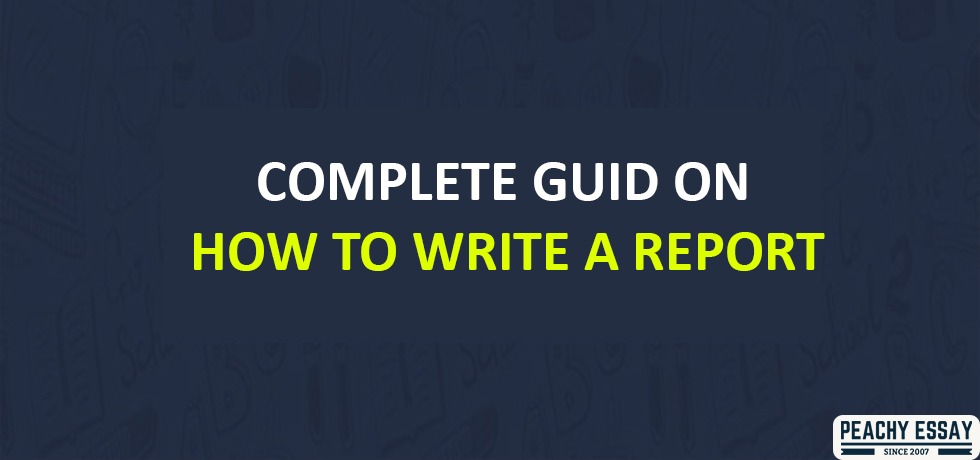Complete Guide on How to Write a Report
There are academic assignments that require the students to write reports instead of an essay. More often, students have a difficult time differentiating between the two types of academic writing. Although the term report and essay are used interchangeably, there is a significant difference between the two. Report writing is mostly used for technical and scientific subjects. Whereas an essay focuses on the facts, an essay, on the other hand, presents arguments and reasoning. By definition, a report is a sharp, short, and concise document that is written for a specific purpose and audience. It sets out and analyses a problem or a situation and thereafter makes a recommendation for future solutions. The paper needs to be well-structured and clear. Most college students state that they do not like writing reports because the entire process is tiring and time-consuming. However, students struggling to write their reports can always seek assistance from companies providing essay writing services.
The requirements for writing a report will vary from one educational institution to another, from one examiner to another, as well as the department, which an individual studies. A well-written report may contain the following;
An analysis of the facts or results of a research
A description of a situation or the occurrence of events
A discussion of the outcomes or future recommendations
A conclusion
It is important to note that it is not a must to include all these elements in your report. If you are writing a report for your school assignment, check whether there are any standard guidelines provided or a specific structure, which you should follow. Your report should be structured in such a way that it will lead your audience through the different concepts using a structured format that will enable them to have a better and quick understanding of the provided concepts.
Although there are different types of reports, it is essential that they adhere to the correct format so that it can be easy for your audience to read and understand. It is essential always to remember that a report is different from an essay, journalistic article, or blog post. This is because the primary objective of a report is to present facts concerning a particular subject, event, or situation. Similar to the way there are different types of reports, they are also written differently.
Tips for writing a report
After reading the following tips, you will all agree that there is nothing that is rocket science. To begin with, a report is a document that is meant to be read by another person. Therefore, if this is the primary objective, most of the focus should be directed to the reader. The following tips will assist you to come up with a quality report.
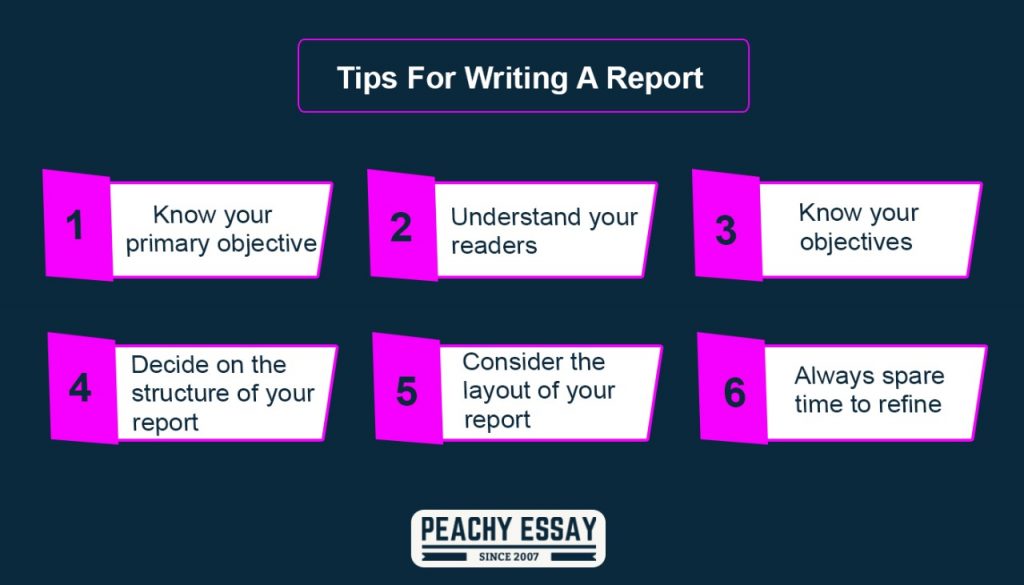
1. Know your primary objective
Asking yourself a question such as what is the aim of your report will assist you in having a good understanding of the kind of report you will write. The majority of the reports written by college students fail to meet their objectives because the writer missed this essential step. Try and think; are you writing a leading, instructional, or factual report?
The primary objective of leading reports is to persuade
The primary objective of instructional reports is to explain
The primary objective of factual reports is to inform
The starting point is always the determining factor of whether your essay will be of good quality or not.
2. Understand your readers
Before you can start writing your report, it is always essential to understand your readers. Apparently, it will be challenging to hit the nail on the head if you cannot have a clear image of the bleeding nail. In other words, if you want to write a quality report, you need to ensure that the readers;
Understand the information presented in the report without struggling
Agree with the findings, facts, and conclusion of your report
Agree with the recommendations provided
Writing a quality report demands more than presenting information accurately since the writer must also be able to communicate intelligibly and acceptably to the reader.
3. Know your objectives
By understanding your readers, you will be able to match them with the expectations of the readers. You should be able to ask yourself, what would you like to know after a reader goes through your report?
4. Decide on the structure of your report
Your report should include the 11 essential elements. However, it is not a must for you to include all of them. Here are the 11 elements;
Title page
Index
Thesis
Introduction
Procedure
Implications
Solutions
Conclusion
Appendices
Bibliography
5. Consider the layout of your report
You should always remember that your report is a formal document, and hence, you should not use fonts that you believe are attractive. It is always advisable that you use a font size of 11 or 12 and a font type of Times New Roman, Calibri, or Arial.
You also need to spend an adequate amount of your time thinking about the visuals, such as diagrams and images that you will use in your report. If possible, always provide an explanation of the different aspects of visuals and avoid leaving the reader wondering about the relationship between the text and the figures.
5. Always spare time to refine
There is no perfect report, mainly when it is the first draft. Most of the well-written reports are those that have been edited a couple of times. After you have completed writing your report, you should always leave as much time as possible to double-check your work and see whether your report has attained its primary objective and whether your audience will be pleased by it.
What is the format of report writing?
The following are the main elements in the format of a report;
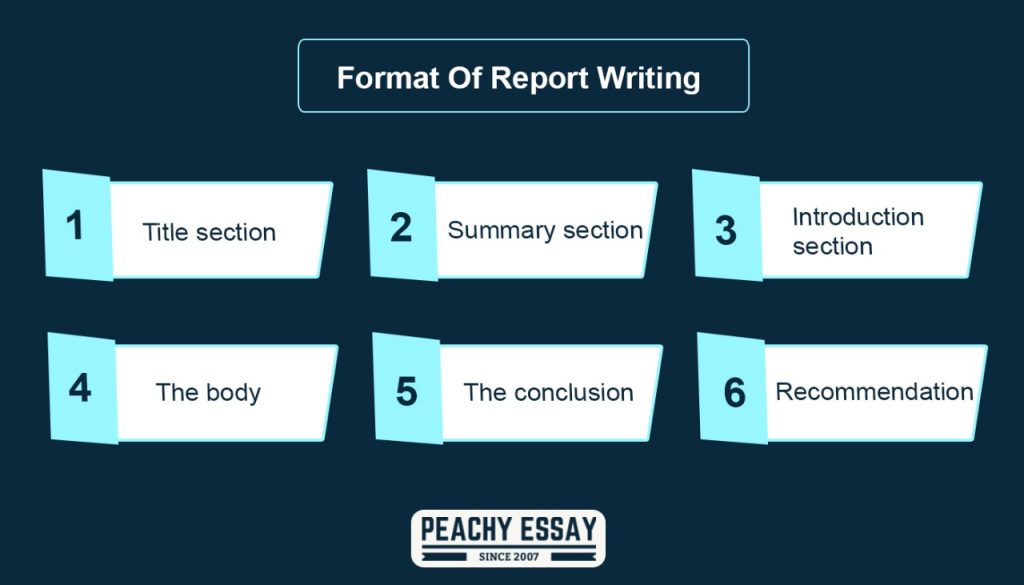
Title section
Your report’s title section should include the author’s names, institution affiliation, and the date the report was published.
Summary section
The summary section should summarize the main points, the conclusion, as well as the recommendation. Although it is short, it should be able to provide an overview of your report. Some people skim through the summary section to get an idea of the different concepts presented in the report. Therefore, you should write this section last so that you may avoid leaving out important information.
Introduction section
It is usually the first page of the report. The writer presents the intentions of the report to the reader. You may also include the definition of terms in the introductory section and provide a well-detailed description of how the report is arranged.
The body
It is the main section of the report. There need to be different sections, each one of them containing a subtitle. The information presented in the report should be arranged in the order of importance with the most vital ones presented at the beginning.
The conclusion
Your conclusion should summarize the main ideas of your report. You should try as much as possible to avoid using jargon in your conclusion since most people will simply go through your introduction and conclusion.
Recommendation
This section contains information on the things or action plans that need to be done. You should arrange your recommendation in the order of importance or priority.
Best Report Writing Format Tips
Report writing is one of the academic assignments that you are most likely to do while a student. Although the process may be similar to writing an essay, it is essential to know the differences between the two. A report can be presented in a verbal or written form. Since, in most cases, you will be required to present your report through a written document, you must have a good understanding of the structure you could use in building your report. More often, your report’s structure will not be different from that of an essay since it may comprise the introduction, body paragraphs, and the conclusion. One of the differences is that your report’s body will be slightly smaller than that of the essay. The following are report writing format tips;
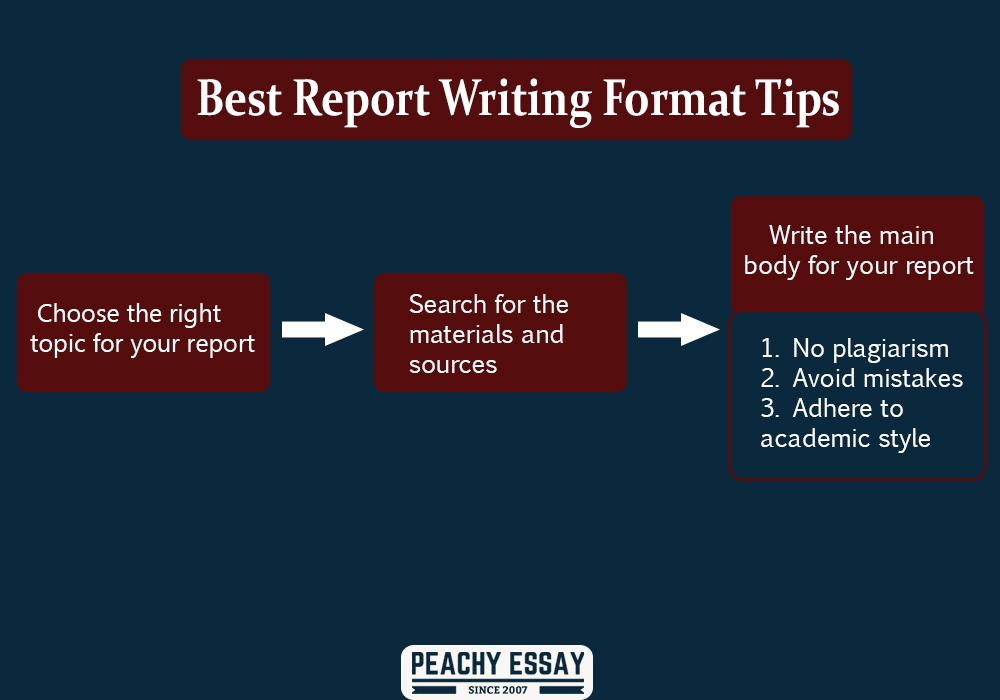
1. Choose the right topic for your report
The topic you choose for your essay will play a significant role in determining your essay’s quality. Apparently, choosing the right topic for your report will be easier if your examiner gave you a list from which you are supposed to select the topic of your interest. If you are given the freedom to choose the topic, always settle for the one that inspires and looks promising.
2. Search for the materials and sources
Considering that you can always find tons of thousands of research materials online for both board discussions and scientific research, it should not be challenging to look for sources and materials. However, always ensure that you are using credible sources of information.
3. Write the main body for your report
Writing the main body of your report can be divided into three parts: the preparation of the thesis statement, the creation of the outline, and finally, writing the introduction and conclusion. Your thesis statement should contain the main idea as well as the basis of your report. Different from an essay, one thesis statement is enough when it comes to writing a report. You can either present your arguments first, then your thesis statement later, or vice versa. After you have completed writing your thesis statement, the next thing you should write is your outline. The final step, which is report writing, should adhere to the following;
No plagiarism: Avoiding borrowing information without giving credit to the authors. Always make use of a plagiarism checker to ascertain that your work is free from plagiarism.
Avoid mistakes: There is nothing as frustrating to a reader as going through a report with spelling mistakes, wrong punctuations, and poor sentence construction.
Adhere to academic style: Avoid trying to sound too professional by using simple words, which are easy to understand.
The final part of writing your report should be the introduction and the conclusion. Your introduction should include your thesis statement and the goals as well as objectives of your paper.
How to write the introduction of your report
A report is typically written to analyze, discuss, and provide recommendations concerning a specific event, situation, or activity. One of the essential parts of any report is the introduction section. It is one of the parts in a report that is most read and informs the reader about what the essay will talk about. The following are tips on how to write a remarkable introduction for your report.
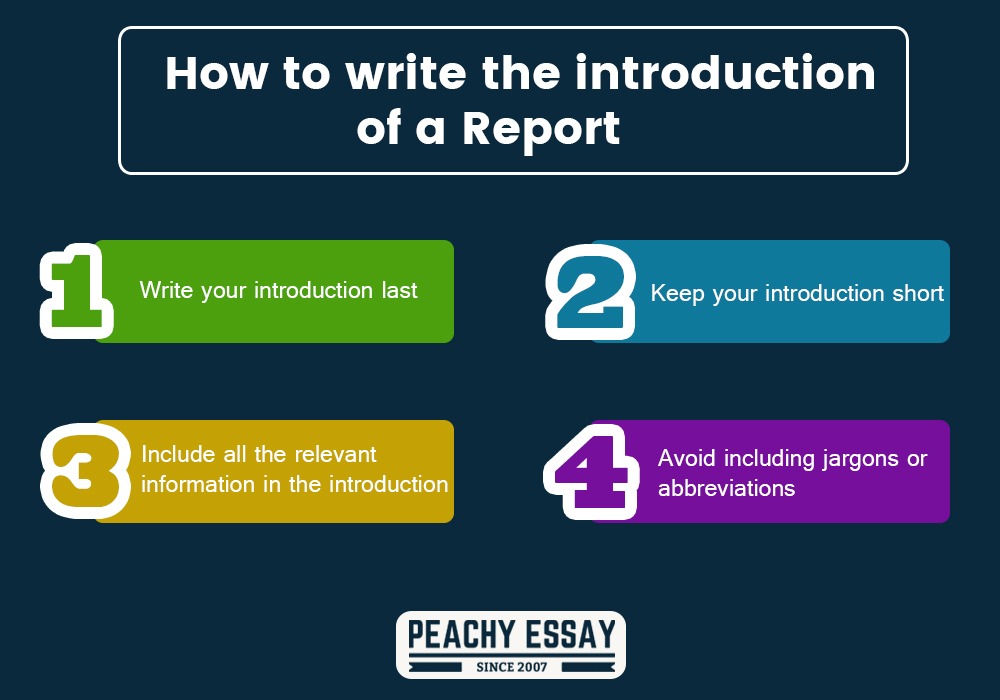
1. Write your introduction last
One of the major mistakes most students make is writing their introduction before writing the body of their report. You should avoid writing your introduction until you have completed the body of your report. The introduction section usually contains a summary of what has been written in the report. Hence, it would beat the logic to summarize what is included in the report before completing your paper.
2. Keep your introduction short
Your introduction should contain just a few lines. This is because it is a brief paragraph intended to inform the reader of the information covered in the report. Your introduction will aid in determining whether the readers should continue reading your report or not.
3. Include all the relevant information in your introduction
Your report should be able to answer the following;
What is the primary objective for writing your report? Apparently, if you are having difficulties answering this question, there is a high probability that the report was not written with a purpose. However, this is unlikely to happen because of the apparent reason that reports aim at addressing a particular event, situation, or problem. You should describe the problem and provide reasons for why it is essential. You should also be able to respond to the question of who will commission your report. Describe the person that requested the report to be written and state whether it was an individual, organization, or department. Also, describe the information covered in the report and, if possible, state what will not be covered in the report.
Avoid including jargons or abbreviations
Always avoid including abbreviations or jargon in the introduction of your report. However, you can only apply this tip after understanding your readers. You can use the terminology if you believe that the readers have a good understanding of the language. However, if you feel that the people who are going to read your report will have a difficult time understanding the abbreviations or jargon, you need to avoid using them at all costs.
Read more: How to Write a Non-Chronological Report
How to write the body of your report
The body of a report is a detailed section that allows the reader to gain an in-depth knowledge of what is contained in the report. In other words, the body of your essay should describe what you have done, how you did it, the results, outcome, conclusion, and finally, the recommendations. The body of your report should contain the following sections; introduction, background, procedures, results, discussion of results, conclusion, and recommendation. Ensuring there is a smooth transition from one paragraph to another will assist the reader to understand the flow of ideas without struggling.
What are the types of reports?
When was the last time that you were told to write a report? I am sure you might have come across different types of reports during your campus life. If you do not like always to get caught unprepared, particularly when you are told to write a report by your examiner, it is always advisable to familiarize yourself with the different reports. It is important to note that every report has different characteristics, and hence, it is essential to classify each one of them into different categories as illustrated below;
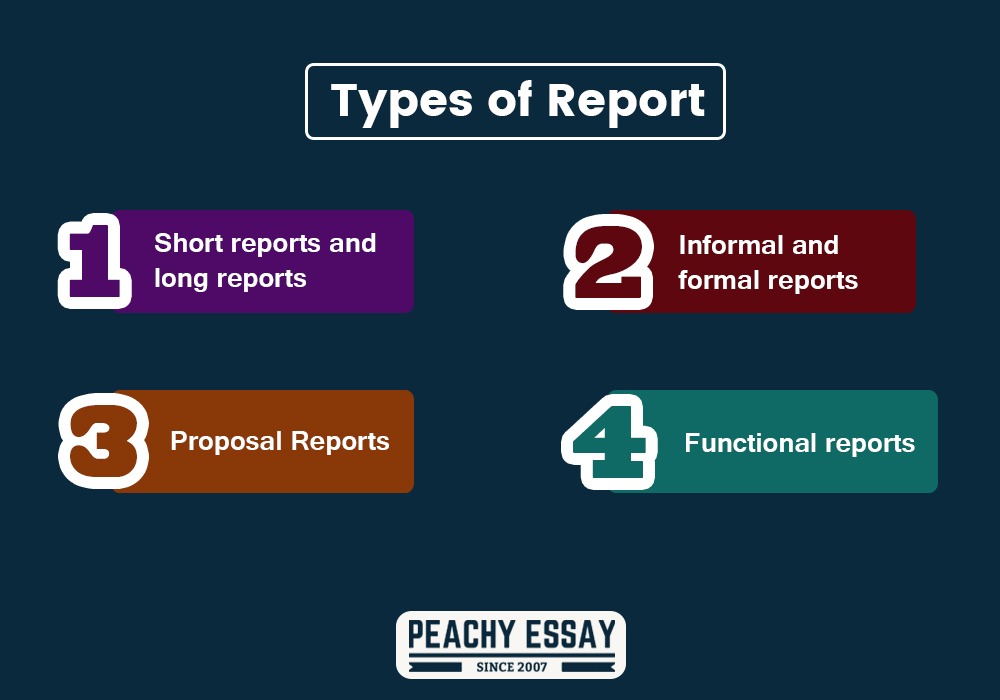
1. Short reports and long reports
Whereas a short report is always referred to as information and it consists of less than ten pages, a long report, on the other hand, is regarded as formal and it contains more than ten pages.
2. Informal and formal reports
A formal report is a uniquely designed document that is intended for a particular organization or institution. These kinds of reports are detailed, and you will rarely find personal pronouns, and they may include; an audit report and analytical reports. On the other hand, informal reports are written in a casual language and are short, although their length is not defined.
3. Proposal reports
Am sure you might have come across problem solving or analytical reports. Proposal reports usually are an extension of both problems solving and analytical reports. Although there are different kinds of reports, there are some that are oriented towards finding solutions. Such kinds of reports are normally identified as personalized reports.
4. Functional reports
This kind of essay may be easy for a student to identify. Such kinds of reports include marketing reports, accounting, and financial reports. Once you know the basics of the different essay types, the next thing you should start writing is your report.
What is the structure of a good report?
The paper’s body is what comes to mind when an individual begins to think of how to write a report. You should include the following elements in the structure of your report;
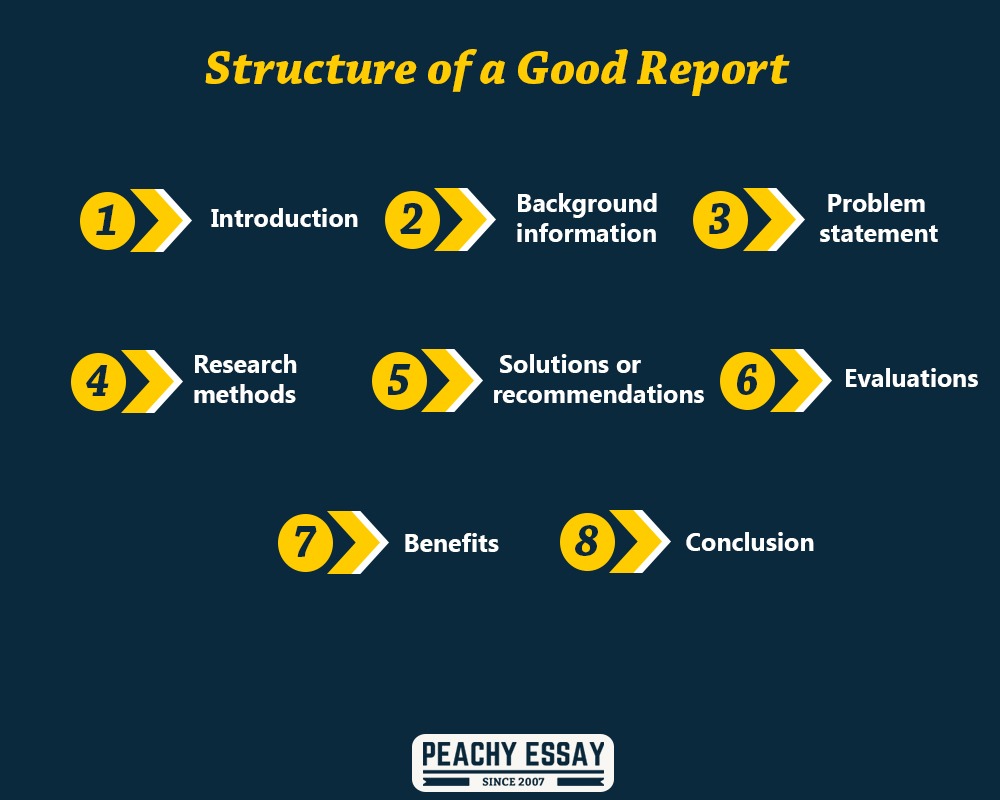
The introduction
The introduction presents the structure of your report. In other words, your introduction should inform the reader what the essay is about and how various events will follow each other. The introduction should also educate the reader on the different criteria used to instigate the report’s creation. The introduction section is mostly used in analytical and informational reports. In some exceptional situations, the introduction may foreshadow the information presented in the conclusion. Your introduction may also cover the problem statement or the purpose of the report.
Background information
The background information describes the various circumstances that instigated the creation of the report. In other situations, you may label this section of the report as constraints or criteria. This section may appear in both formal and informal reports. Your background information should include the basis of the current situations, possible future constrictions regarding a human resource, time, and budgeting.
Problem statement
In most reports, the section of the problem statement is usually part of the background information. Other times, this section may stand independently depending on the report’s complexity.
Research methods
The research section is, at times, referred to as the methods section. This is where the writer established credibility as they indicate their perspective as supported by other authors. By informing your audience of the procedure you used to develop your findings, your readers will feel confident and comfortable implementing the changes mentioned in your recommendation section.
Solutions or recommendations
This section may be written independently, depending on the complexity of your report. The recommendation and solution section is mostly used in writing analytical reports. While writing this section, you should begin with your first choice of recommendations. Thereafter, you should explain why you prioritize each of your choices by demonstrating each facet’s operational, structural, economical, and feasibility. Always remember that you are allowed to provide suggestions that you do not recommend.
Evaluations
This should be a significant part of your report. You should evaluate your different options using the criteria you mentioned in your methods section. You can add charts or graphs to indicate that you have a good understanding of your different options and back up your reasoning with statistics.
Benefits
This section should provide the benefits of the different solutions you have presented. It would be best if you were sure that the solutions you have presented in your report would benefit the institution or organization of your interest. Although some people may argue that this section is unnecessary, it is always good to explain why something is proposed.
Conclusion
The conclusion is the last section of your report. It provides a summary of the main ideas presented in the report. Your paper’s last body paragraph should never introduce new ideas or facts that were not presented earlier in the report. In your conclusion, you should describe the reasons why a company should adhere to the recommendations presented in the paper. You should also compare the different statistics presented and thereafter assist the reader in understanding the logic of the cause of action. Your conclusion should also reinstate your thesis statement.
The final word
Writing a report, just like any other type of academic writing, requires the reader to enhance their writing skills. At times, working on your assignments may be so overwhelming to the extent that you do not have time to attend to other essential activities. Students struggling to complete their assignments, and particularly reports, are always encouraged to seek assistance from companies providing essay writing services. If you are struggling to write your papers despite adhering to all the tips provided in this article, you should never think of giving up. With enough practice, you will, without a doubt, enhance your writing skills.

